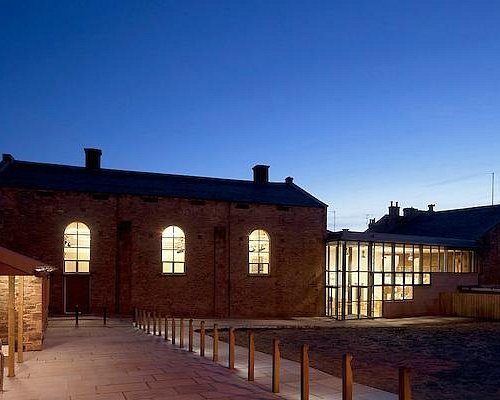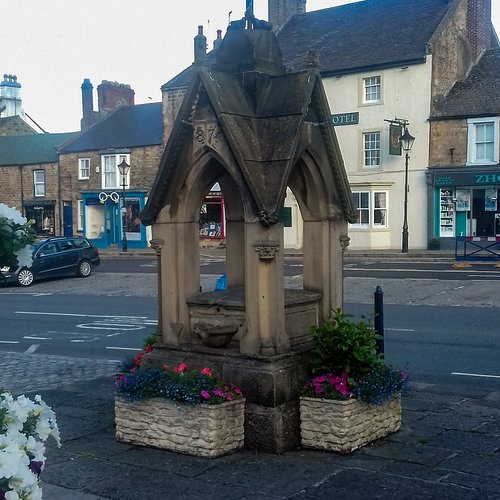What to do and see in Barnard Castle, England: The Best Points of Interest & Landmarks
Barnard Castle is a market town in Teesdale, County Durham, England. It is named after the castle around which it grew up. It is the main settlement in the Teesdale area, and is a popular tourist destination. The Bowes Museum has the best collection of European fine and decorative arts in the North of England, housed in a "magnificent" 19th-century French-style chateau. Its most famous exhibit is the 18th-century Silver Swan automaton, though art includes work by Goya and El Greco.
Restaurants in Barnard Castle
1. Market Cross
2. Hole in the Wall
3. The Witham
Overall Ratings
4.5 based on 112 reviews
The Witham is a vibrant Arts Centre for cultural, community and commercial use, offering a 240 seat performance venue, a gallery space, function and meeting rooms, a cafe bar, a visitor information point and studio space for creative businesses.
Reviewed By shirleyj432
Great place for coffee and scones/cake, or light lunches. Good choice of basic food, well presented, friendly staff.
4. County Bridge
Overall Ratings
4.0 based on 3 reviews
Reviewed By Barnard-Castle-Org - Barnard Castle, United Kingdom
"Barnard's bridge of stately stone."— Sir Walter Scott. This arched bridge was probably late medieval originally, dating from the 14th Century. It was rebuilt after a siege of Barnard Castle damaged it. It bears a date stone of 1596, which replaced an earlier stone - a mistake by the stonemason, that stated 1569 (the year of Sir George Bowes' siege of the castle). On Tuesday, October 24th, 1648 Oliver Cromwell crossed this bridge on his way to Richmond after his stay at Blagraves.. In 1745, a division of the royal forces, marching from the west, to join the main army, than in pursuit of the ' Young Pretender," crossed this bridge and encamped for two days near the town. It is called the "County Bridge", as it was formerly the boundary between County Durham and Yorkshire. The downstream bay has a plate with the inscription "Y N R" for Yorkshire North Riding. In the early 17th century, Illicit weddings took advantage of the centre of the bridge not being in either county. So, the bridge was known at one point as the "Broomstick Bridge" as the upstream bay in the middle of the bridge was once a temporary chapel where Illicit wedding ceremonies were performed, by an 18th Century bogus parson named Cuthbert Hilton. He had learnt the bible from his father who was a curate. At the end of each ceremony the newly wedded pair, who had paid him half a crown, were obliged to jump over a broomstick, held by Hilton across the county boundary, to seal the knot. After the leap he would say the following rhyme... My blessings on your pates, And your groats in my purse, You are never the better, And I am never the worse. Cuthbert had 6 sons who became the first artisans here in dyeing cloth. Hilton pursued his unlawful calling for several years, making Barnard Castle a kind of Gretna Green. For many years thereafter, people talked of the disastrous results of these unhallowed marriages.The phrase "living over the brush" is still used to describe an unmarried couple who live together. The tiny bay was also home to Tom Suggett, the cobbler's cottage at the time of the great flood in 1771. The building adjoining the bridge, until recent years, was the White Swan pub. This was originally weavers' cottages. The steps downstream of the building are all that remains of three other houses. On the bridge next to the Swan (previously called the Bridge Inn), was a turnpike or toll gate, also manned at the time of the great flood by George Taylor. Another carving on top of the wall, just to the Startforth side of the downstream bridge bay says "C Raine 1816", to show where Catherine Raine was thrown to her death. On the castle side of the bridge behind the traffic light used to be the toll-house. The original building and 8 other nearby houses were washed away by the 1771 flood, but another toll house was built in the same place. lts window faced the road, for the toll-keeper to watch out for travellers. There was a little hatch to the right of the door to accept payment. There were varying charges for pedestrians, horses, carts, calves, wheelbarrows, pigs, sheep, or lamb. The Bridge was also the arena on Wednesdays of many a fierce local combat between the "sons of the pick (heelanders)," and the "poor silly weavers", as they called each other in derision. Severe contusions and even broken limbs, were frequently the consequence. One such battle was on Whit Wednesday 1816 at 2pm, when the market was interrupted by brawls and rioting, including "rough & tumble fighting with heavy bludgeons". Single fights were held in pubs but conflicts on a larger scale were held on the Flatts, Desmesnes & the Churchyard. Some miners ended up in the "Market Cross Black Hole". In February 1865, King James the Second, was proclaimed on this bridge and at the Market Cross, with a flourish of silver trumpets and brazen drums. The gentry assembled at Blagraves and spent £20, in drinking to the King's health. There is a photo of King Edward VII crossing the bridge in 1907, coming back from a shooting party. He used to come to the area regularly for this.
5. The Drinking Fountain
The cattle market used to be held in this lower wider part of Galgate. The elaborate Gothic stone drinking fountain, drinking fountain that is still in the centre, was designed to serve both man and beast. It was fed by an underground spring. Paid for by public subscription, it was erected in 1874. It ceased use in 1992.





